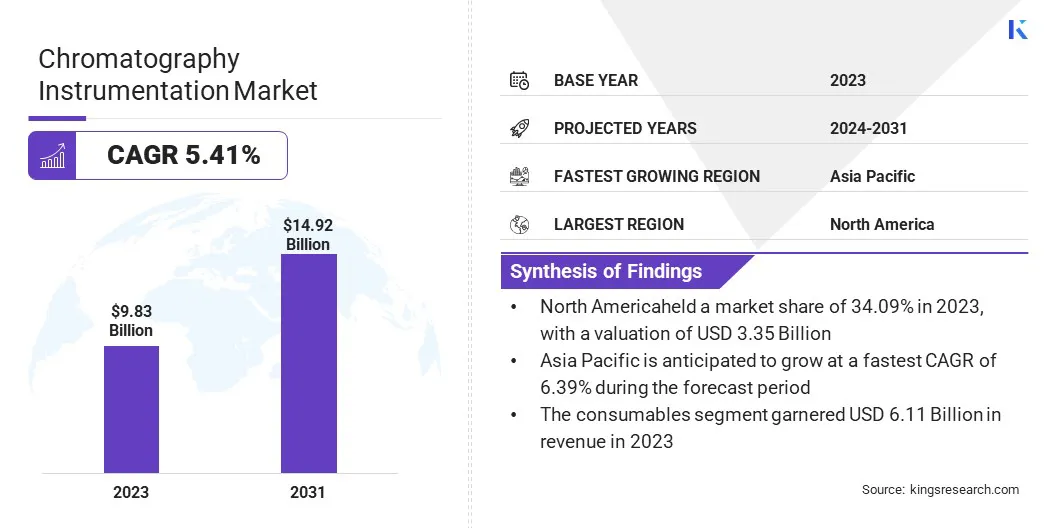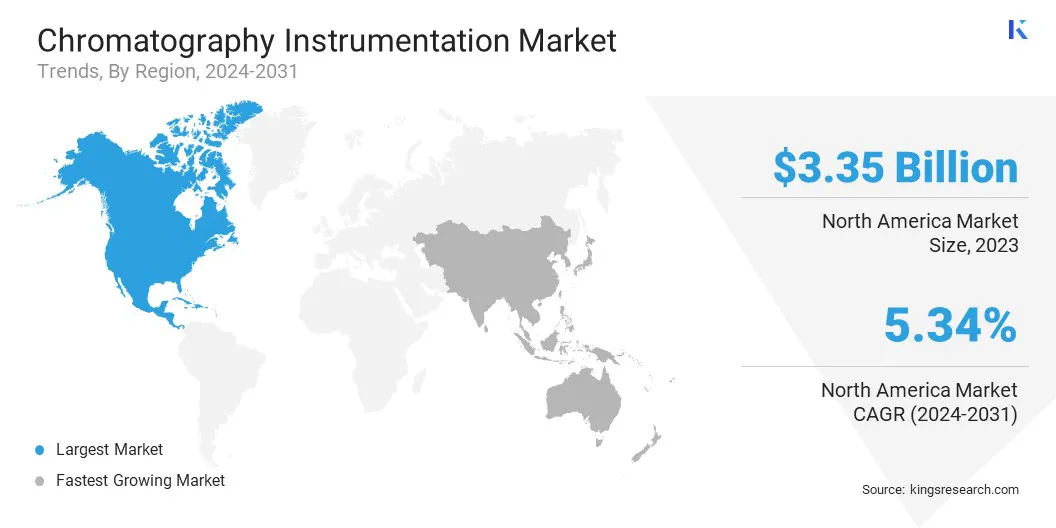Market Definition
The market involves the development, production, and sale of equipment used in chromatography. Chromatography is a laboratory technique for separating mixtures into their individual components based on their chemical properties.
The report provides a comprehensive analysis of key drivers, emerging trends, and the competitive landscape expected to influence the market over the forecast period.
Chromatography Instrumentation Market Overview
The global chromatography instrumentation market size was valued at USD 9.83 billion in 2023 and is projected to grow from USD 10.32 billion in 2024 to USD 14.92 billion by 2031, exhibiting a CAGR of 5.41% during the forecast period.
The growing need for accurate and reliable testing in biopharmaceuticals, food safety, and environmental analysis is fueling this growth. Chromatography is essential for quality control, ensuring product safety and regulatory compliance. The increasing emphasis on health, safety, and sustainability is fostering the adoption of advanced chromatographic instruments across these sectors.
Major companies operating in the chromatography instrumentation industry are Agilent Technologies India Pvt. Ltd., Shimadzu Corporation, Waters Corporation, Thermo Fisher Scientific Inc., Sartorius AG, PerkinElmer Inc., Bio-Rad Laboratories, Inc., Centurion Scientific Ltd., Restek Corporation, Phenomenex, Cytiva, SCION Instruments, Hitachi, Danaher, and Merck KGaA.
The growing need for versatile and space-efficient instruments is creating a demand for portable and compact chromatography systems. These systems address the growing need for high performance liquid chromatography across diverse settings.
- In March 2025, Axcend, a leader in compact capillary liquid chromatography, introduced a space-saving, full-stack chromatography system based on the Axcend Focus LC. The system includes a 40-vial/96-well plate autosampler, an in-line process analytical technology monitoring system, and a full-spectrum diode array detector, enabling high-performance liquid chromatography (HPLC) anywhere.
 Key Highlights:
Key Highlights:
- The chromatography instrumentation industry size was recorded at USD 9.83 billion in 2023.
- The market is projected to grow at a CAGR of 5.41% from 2024 to 2031.
- North America held a market share of 34.09% in 2023, with a valuation of USD 3.35 billion.
- The consumables segment garnered USD 6.11 billion in revenue in 2023.
- The gas chromatography systems segment is expected to reach USD 5.39 billion by 2031.
- The agriculture segment is anticipated to witness the fastest CAGR of 5.71% over the forecast period
- Asia Pacific is anticipated to grow at a CAGR of 6.39 % through the projection period.
Market Driver
"Technological Advancement"
Technological advancements in liquid chromatography systems are propelling the growth of the chromatography instrumentation market. These developments are improving analysis accuracy, resolution, and speed, making it easier to detect complex compounds with precision.
Innovations such as advanced surface technologies and automated functionalities enhance operational efficiency while reducing errors and downtime. These improvements cater to the growing demand for high-quality testing in sectors such as pharmaceuticals, food safety, and environmental monitoring.
- In April 2024, Waters Corporation launched the Alliance iS Bio High Performance Liquid Chromatography (HPLC) System, designed to help biopharmaceutical QC laboratories increase efficiency and eliminate up to 40% of common errors. The system features MaxPeak High Performance Surface (HPS) Technology to minimize analyte interactions, enhancing resolution and sensitivity while reducing peak tailing, particularly for metal-sensitive analytes.
Market Challenge
"High Costs of Chromatography Instruments"
A major challenge hampering the expansion of the chromatography instrumentation market is the high cost of advanced instruments and their maintenance, which limits access for smaller laboratories and research facilities.
These high costs make it difficult for smaller labs to afford the equipment they need, potentially delaying research and limiting their ability to perform accurate analyses.
To address this challenge, companies can focus on creating affordable, modular instruments with lower initial costs. This allows smaller labs to buy equipment that meets their needs without a large upfront investment.
Additionally, offering cost effective maintenance options can help labs manage ongoing expenses and make it easier for them to continue using the equipment over time.
Market Trend
"Shift Toward Modular and Adaptable Equipment"
A notable shift toward modular and adaptable equipment is supporting the progress of the chromatography instrumentation market as laboratories seek more flexible solutions that can be easily adjusted for various types of tests.
This shift reflects the increasing demand for instruments that can easily be customized to meet changing needs, without the need for purchasing entirely new equipment. Additionally, laboratories are increasingly seeking instruments that can handle a wide variety of analyses using modular equipment.
- In February 2024, Thermo Fisher Scientific Inc. launched the Thermo Scientific Dionex Inuvion Ion Chromatography (IC) system, designed to support a wider range of ion chromatography analysis with a single instrument. This innovative system simplifies ion analysis, making it more intuitive for labs of all sizes. The system is reconfigurable and offers a one-stop solution for consistent, reliable ion analysis, particularly for the determination of ionic and small polar compounds.
Chromatography Instrumentation Market Report Snapshot
|
Segmentation
|
Details
|
|
By Device
|
Consumables (Columns, Solvents/Reagents/Adsorbents, Syringes/Needles, Others), Accessories (Column Accessories , Auto-Sampler Accessories, Pumps, Others)
|
|
By Systems
|
Gas Chromatography Systems, Liquid Chromatography Systems, Fluid Chromatography Systems, Thin Layer Chromatography Systems
|
|
By Application
|
Pharmaceutical Firms, Agriculture, Clinical Research Organizations, Environmental Testing
|
|
By Region
|
North America: U.S., Canada, Mexico
|
|
Europe: France, U.K., Spain, Germany, Italy, Russia, Rest of Europe
|
|
Asia-Pacific: China, Japan, India, Australia, ASEAN, South Korea, Rest of Asia-Pacific
|
|
Middle East & Africa: Turkey, UAE, Saudi Arabia, South Africa, Rest of Middle East & Africa
|
|
South America: Brazil, Argentina, Rest of South America
|
Market Segmentation:
- By Device (Consumables (Columns, Solvents/Reagents/Adsorbents, Syringes/Needles, Others), Accessories (Column Accessories, Auto-Sampler Accessories, Pumps, Others ): The consumables segment earned USD 6.11 billion in 2023 due to the increasing demand for laboratory testing and research across multiple industries.
- By Systems (Gas Chromatography Systems, Liquid Chromatography Systems, Fluid Chromatography Systems, and Thin Layer Chromatography Systems): The gas chromatography systems segment held a share of 36.22% in 2023, fueled by their extensive use in chemical analysis, environmental monitoring, and the pharmaceutical industry.
- By Application (Pharmaceutical Firms, Agriculture, Clinical Research Organizations, and Environmental Testing): The pharmaceutical firms segment is projected to reach USD 5.52 billion by 2031, propelled by the growing focus on drug development, quality control, and regulatory compliance.
Chromatography Instrumentation Market Regional Analysis
Based on region, the market has been classified into North America, Europe, Asia Pacific, Middle East & Africa, and South America.
 North America chromatography instrumentation market accounted for a share of around 34.09% in 2023, valued at USD 3.35 billion. This dominance is reinforced by its advanced healthcare infrastructure, strong presence of leading pharmaceutical and biotechnology companies, and a robust regulatory environment.
North America chromatography instrumentation market accounted for a share of around 34.09% in 2023, valued at USD 3.35 billion. This dominance is reinforced by its advanced healthcare infrastructure, strong presence of leading pharmaceutical and biotechnology companies, and a robust regulatory environment.
High R&D spending across industries such as pharmaceuticals, environmental testing, and food safety is leading to continuous demand for sophisticated analytical instruments.
Furthermore, the presence of key market players, coupled with continuous technological advancements, and mergers and acquisitions, further solidifies the region's dominance.
- In July 2024, Thermo Fisher Scientific completed its acquisition of Olink Holding, a Swedish leader in next-generation proteomics, for approximately USD 3.1 billion. This acquisition grants Thermo Fisher access to Olink's proprietary Proximity Extension Assay (PEA) technology, which enables high-throughput protein analysis via quantitative polymerase chain reaction and next-generation sequencing.
The Asia Pacific chromatography instrumentation industry is set to grow at a robust CAGR of 6.39% over the forecast period. This growth is bolstered by the rapidly expanding pharmaceutical and agriculture industry.
Countries such as China, Japan, and India are witnessing significant growth in their life sciences industries., The region’s rising focus on environmental monitoring and food safety regulations further fuels the adoption of chromatography technologies.
Furthermore, strategic partnerships and collaborations between global chromatography companies and local businesses are strenghthening market presence and addressing the growing demand for advanced analytical solutions.
Regulatory Frameworks
- In the U.S., chromatography instrumentation and methods are regulated primarily by the Food and Drug Administration (FDA) for clinical use and the US Pharmacopeia (USP) for general analytical methods. The FDA overssess devices such as gas liquid chromatography systems in clinical analysis, while the USP provides guidelines for chromatographic procedures, including column specifications and method validation.
- In Europe, chromatography instrumentation is governed by several regulatory frameworks to ensure accuracy, reliability, and safety. The European Pharmacopoeia (Ph. Eur.) sets requirements for chromatographic methods, such as system suitability tests, system repeatability, and conditions for method adjustment.
- In India, the Central Drugs Standard Control Organization (CDSCO) for pharmaceuticals regulates the pharmaceutical industry, ensuring the quality and purity of drugs and active pharmaceutical ingredients.
- In Japan, chromatography instrumentation is regulated by various agencies to ensure safety and quality in the pharmaceutical and food industries. The Pharmaceuticals and Medical Devices Agency (PMDA) regulates the Japanese Pharmacopoeia (JP), setting standards for medicinal products and their testing. The Japanese Standards Association (JSA) oversees the Japanese Industrial Standards (JIS), which govern technical specifications and quality standards for industrial applications.
Competitive Landscape
The chromatography instrumentation industry is characterized by a moderately consolidated competitive landscape, comprising both established multinational corporations and specialized regional players.
Market players are focusing on strategic partnerships, simplifying gas chromatography systems, improving cost efficiency and operational performance. Additionally, mergers and acquisitions are allowing market leaders to expand their product portfolios and geographical reach.
- In February 2024, Shimadzu Corporation acquired the business of catalytic microreactor for gas chromatography from Activated Research Company, based in the USA. This acquisition supports Shimadzu’s Green Transformations initiative, aimed at achieving carbon neutrality through alternative energy sources such as hydrogen and biofuels, as well as carbon dioxide capture and utilization. The growing demand for gas chromatographs (GCs) to analyze these compounds, and Shimadzu’s acquisition addresses the need for more efficient and cost-effective systems.
List of Key Companies in Chromatography Instrumentation Market:
Recent Developments (M&A/Partnerships/New Product Launch)
- In January 2025, Shimadzu collaborated with SepSolve Analytical to advance comprehensive two-dimensional gas chromatography time-of-flight mass spectrometry (GCxGC-TOF MS) technology to laboratories. This strategic partnership combines Shimadzu (Asia Pacific)’s industry-leading expertise with SepSolve Analytical’s specialization in multi-dimensional chromatography, creating a robust platform for complex non-targeted analysis in modern laboratories.
- In October 2024, Agilent Technologies Inc. launched the new InfinityLab LC Series, which includes the 1290 Infinity III, 1260 Infinity III Prime, and 1260 Infinity III systems. Agilent’s new Liquid Chromatography systems feature InfinityLab Assist Technology, which enhances automation, reduces manual tasks, and improves operational efficiency. They also feature built-in sample tracking using barcoding and camera technology, minimizing errors and ensuring greater accuracy.
- In June 2024, CatSci Ltd acquired Reach Separations, a specialist chromatography provider for the analysis and purification of therapeutics. This strengthens its innovation capabilities in medicines development.
- In April 2024, Valmet Oyj acquired the Process Gas Chromatography & Integration business from Siemens AG. The acquisition aims to strengthen the business footprint in North America, Asia-Pacific, and Europe.

 Key Highlights:
Key Highlights: North America chromatography instrumentation market accounted for a share of around 34.09% in 2023, valued at USD 3.35 billion. This dominance is reinforced by its advanced healthcare infrastructure, strong presence of leading pharmaceutical and biotechnology companies, and a robust regulatory environment.
North America chromatography instrumentation market accounted for a share of around 34.09% in 2023, valued at USD 3.35 billion. This dominance is reinforced by its advanced healthcare infrastructure, strong presence of leading pharmaceutical and biotechnology companies, and a robust regulatory environment.